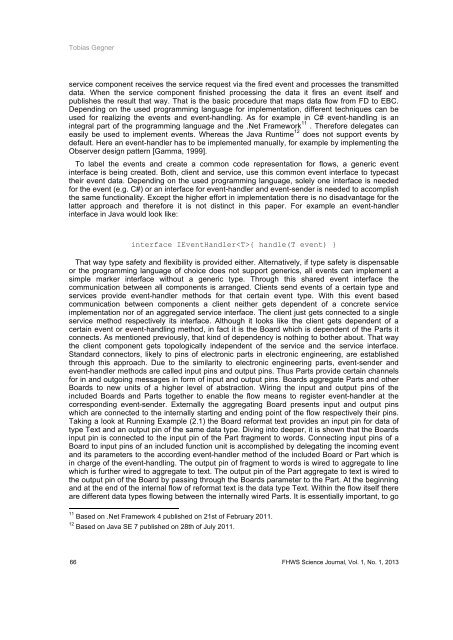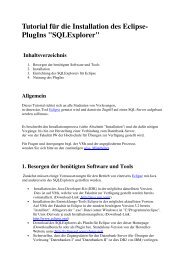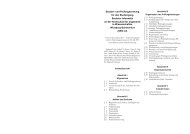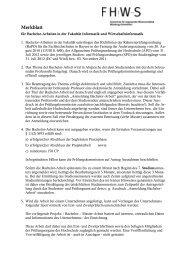FHWS Science Journal - Fakultät Informatik und Wirtschaftsinformatik
FHWS Science Journal - Fakultät Informatik und Wirtschaftsinformatik
FHWS Science Journal - Fakultät Informatik und Wirtschaftsinformatik
You also want an ePaper? Increase the reach of your titles
YUMPU automatically turns print PDFs into web optimized ePapers that Google loves.
Tobias Gegner<br />
service component receives the service request via the fired event and processes the transmitted<br />
data. When the service component finished processing the data it fires an event itself and<br />
publishes the result that way. That is the basic procedure that maps data flow from FD to EBC.<br />
Depending on the used programming language for implementation, different techniques can be<br />
used for realizing the events and event-handling. As for example in C# event-handling is an<br />
integral part of the programming language and the .Net Framework 11 . Therefore delegates can<br />
easily be used to implement events. Whereas the Java Runtime 12 does not support events by<br />
default. Here an event-handler has to be implemented manually, for example by implementing the<br />
Observer design pattern [Gamma, 1999].<br />
To label the events and create a common code representation for flows, a generic event<br />
interface is being created. Both, client and service, use this common event interface to typecast<br />
their event data. Depending on the used programming language, solely one interface is needed<br />
for the event (e.g. C#) or an interface for event-handler and event-sender is needed to accomplish<br />
the same functionality. Except the higher effort in implementation there is no disadvantage for the<br />
latter approach and therefore it is not distinct in this paper. For example an event-handler<br />
interface in Java would look like:<br />
interface IEventHandler{ handle(T event) }<br />
That way type safety and flexibility is provided either. Alternatively, if type safety is dispensable<br />
or the programming language of choice does not support generics, all events can implement a<br />
simple marker interface without a generic type. Through this shared event interface the<br />
communication between all components is arranged. Clients send events of a certain type and<br />
services provide event-handler methods for that certain event type. With this event based<br />
communication between components a client neither gets dependent of a concrete service<br />
implementation nor of an aggregated service interface. The client just gets connected to a single<br />
service method respectively its interface. Although it looks like the client gets dependent of a<br />
certain event or event-handling method, in fact it is the Board which is dependent of the Parts it<br />
connects. As mentioned previously, that kind of dependency is nothing to bother about. That way<br />
the client component gets topologically independent of the service and the service interface.<br />
Standard connectors, likely to pins of electronic parts in electronic engineering, are established<br />
through this approach. Due to the similarity to electronic engineering parts, event-sender and<br />
event-handler methods are called input pins and output pins. Thus Parts provide certain channels<br />
for in and outgoing messages in form of input and output pins. Boards aggregate Parts and other<br />
Boards to new units of a higher level of abstraction. Wiring the input and output pins of the<br />
included Boards and Parts together to enable the flow means to register event-handler at the<br />
corresponding event-sender. Externally the aggregating Board presents input and output pins<br />
which are connected to the internally starting and ending point of the flow respectively their pins.<br />
Taking a look at Running Example (2.1) the Board reformat text provides an input pin for data of<br />
type Text and an output pin of the same data type. Diving into deeper, it is shown that the Boards<br />
input pin is connected to the input pin of the Part fragment to words. Connecting input pins of a<br />
Board to input pins of an included function unit is accomplished by delegating the incoming event<br />
and its parameters to the according event-handler method of the included Board or Part which is<br />
in charge of the event-handling. The output pin of fragment to words is wired to aggregate to line<br />
which is further wired to aggregate to text. The output pin of the Part aggregate to text is wired to<br />
the output pin of the Board by passing through the Boards parameter to the Part. At the beginning<br />
and at the end of the internal flow of reformat text is the data type Text. Within the flow itself there<br />
are different data types flowing between the internally wired Parts. It is essentially important, to go<br />
11 Based on .Net Framework 4 published on 21st of February 2011.<br />
12 Based on Java SE 7 published on 28th of July 2011.<br />
66 <strong>FHWS</strong> <strong>Science</strong> <strong>Journal</strong>, Vol. 1, No. 1, 2013








